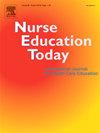Assessing nursing students' perceptions of obstetric violence: A cross-sectional study
IF 3.6
2区 医学
Q1 EDUCATION, SCIENTIFIC DISCIPLINES
引用次数: 0
Abstract
Background
Obstetric violence is a global issue that violates women's rights. To effectively address this problem within healthcare, understanding nursing students' perceptions of this form of violence is essential.
Objectives
This study aims to determine whether nursing students perceive certain clinical practices during labor and delivery as obstetric violence and to identify the factors that influence their perceptions.
Design
A cross-sectional study design was employed.
Settings
The research was conducted within a nursing program at a state university in Türkiye.
Participants
The study included 307 nursing students, with 45.3 % in their third year and 54.7 % in their fourth year.
Methods
Data were collected through face-to-face interviews using a questionnaire that included socio-demographic inquiries, an obstetric violence awareness form, and a 44-item obstetric violence perception form developed by the researchers. Descriptive statistics were computed. The relationship between the total obstetric violence perception score and variables like age and clinical observation count was assessed using Spearman correlation analysis. Both simple and multiple linear regression analyses evaluated factors influencing perception, with p < 0.05 indicating statistical significance. Odds ratios with a 95 % confidence interval were calculated.
Results
Participants had an average perception score of 178.80 (SD: 24.40), indicating a moderate awareness level of obstetric violence, although some clinical practices were not perceived as violent. Gender and academic year were identified as independent determinants; female students had awareness levels 12.620 times higher than males, and third-year students demonstrated levels 6.327 times greater than fourth-year students.
Conclusion
Nursing students were found to have a moderate level of awareness regarding obstetric violence, with their perceptions varying by gender and academic year. These findings underscore the importance of systematically integrating obstetric violence awareness into nursing education to foster respectful and evidence-based maternity care.
Patient or public contribution
No Patient or Public Contribution.
评估护理学生对产科暴力的看法:一项横断面研究
性别暴力是一个侵犯妇女权利的全球性问题。为了有效地解决医疗保健中的这一问题,了解护理学生对这种形式的暴力的看法是必不可少的。目的本研究旨在确定护生是否将分娩过程中的某些临床行为视为产科暴力,并确定影响其认知的因素。设计采用横断面研究设计。该研究是在日本一所州立大学的护理项目中进行的。研究对象包括307名护理专业学生,其中45.3%为大三学生,54.7%为大四学生。方法通过面对面访谈收集数据,使用问卷调查,包括社会人口统计调查,产科暴力意识表和由研究人员开发的44项产科暴力感知表。进行描述性统计。使用Spearman相关分析评估产科暴力感知总分与年龄、临床观察次数等变量之间的关系。简单和多元线性回归分析评估了影响感知的因素,p <;0.05表示有统计学意义。计算了95%置信区间的优势比。结果参与者的平均感知得分为178.80 (SD: 24.40),表明他们对产科暴力的认知水平中等,尽管一些临床实践没有被认为是暴力的。性别和学年被确定为独立的决定因素;女生的认知水平是男生的12.620倍,三年级是四年级的6.327倍。结论护生对产科暴力的认知处于中等水平,性别、学年不同,认知程度不同。这些发现强调了系统地将产科暴力意识纳入护理教育的重要性,以促进尊重和循证产科护理。病人或公众捐款:没有病人或公众捐款。
本文章由计算机程序翻译,如有差异,请以英文原文为准。
求助全文
约1分钟内获得全文
求助全文
来源期刊

Nurse Education Today
医学-护理
CiteScore
6.90
自引率
12.80%
发文量
349
审稿时长
58 days
期刊介绍:
Nurse Education Today is the leading international journal providing a forum for the publication of high quality original research, review and debate in the discussion of nursing, midwifery and interprofessional health care education, publishing papers which contribute to the advancement of educational theory and pedagogy that support the evidence-based practice for educationalists worldwide. The journal stimulates and values critical scholarly debate on issues that have strategic relevance for leaders of health care education.
The journal publishes the highest quality scholarly contributions reflecting the diversity of people, health and education systems worldwide, by publishing research that employs rigorous methodology as well as by publishing papers that highlight the theoretical underpinnings of education and systems globally. The journal will publish papers that show depth, rigour, originality and high standards of presentation, in particular, work that is original, analytical and constructively critical of both previous work and current initiatives.
Authors are invited to submit original research, systematic and scholarly reviews, and critical papers which will stimulate debate on research, policy, theory or philosophy of nursing and related health care education, and which will meet and develop the journal''s high academic and ethical standards.
 求助内容:
求助内容: 应助结果提醒方式:
应助结果提醒方式:


